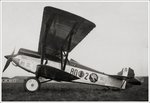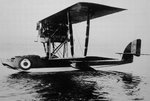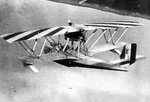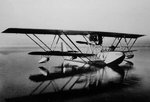Among the earlier adopters of military aviation, Italy's air arm dates back to 1884, when the Italian Royal Army (Regio Esercito) was authorised to acquire its own air component. The Air Service (Servizio Aeronautico) operated balloons based near Rome. In 1911, reconnaissance and bombing sorties during the Italo-Turkish War by the Servizio Aeronautico represented the first ever use of heavier than air aircraft in armed conflict. On 28 March 1923, the Italian air force was founded as an independent service by King Vittorio Emanuele III of the Kingdom of Italy (Regno d'Italia). This air force was known as the Regia Aeronautica (Royal Air Force).
At the beginning of the twentieth century, Italy was at the forefront of aerial warfare: during the colonization of Libya in 1911, it made the first reconnaissance flight in history on 23 October, and the first ever bombing raid on 1 November. During World War I, the Italian Corpo Aeronautico Militare, then still part of the Regio Esercito (Royal Army), operated a mix of French fighters and locally-built bombers, notably the gigantic Caproni aircraft. The Regia Marina (Royal Navy) had its own air arm, operating locally-built flying boats. The Italian air force became an independent service—the Regia Aeronautica—on March 28, 1923. Benito Mussolini's fascist regime turned it into an impressive propaganda machine, with its aircraft, featuring the Italian flag colors across the full span of the undersides of the wings, making numerous record-breaking flights. It reached its zenith when two squadrons of flying boats, led by General Italo Balbo, crossed the Atlantic Ocean in 1931 and 1933 respectively. During the latter half of the 1930s, the Regia Aeronautica participated in the Spanish Civil War, as well as the invasion of Ethiopia.
During the Ethiopian war, the Regia Aeronautica performed massive poison gas bombings and sprayings over the Ethiopian country side using mustard gas and phosgene. Despite being inadequately equipped, the Regia Aeronautica managed to decimate Ethiopian forces and undertook massive bombings of Ethiopian cities (particularly Addis Abeba). The operations of the Regia Aeronautica were crucial for the success of the invasion of the Regio Esercito and was enhanced by the near total lack of an opposing Imperial Ethiopian Air Force.
During the Spanish Civil War Italian pilots fought alongside Spanish Nationalist and German Luftwaffe pilots as members of the "Aviation Legion". This deployment took place from July 1936 to March 1939 and complimented an expeditionary force of Italian ground troops titled "Corps of Volunteer Troops". In Spain, the Italian pilots were under direct command of the Spanish Nationalists and took part in training and joint operations with the pilots of the German "Condor Legion".
At the beginning of the twentieth century, Italy was at the forefront of aerial warfare: during the colonization of Libya in 1911, it made the first reconnaissance flight in history on 23 October, and the first ever bombing raid on 1 November. During World War I, the Italian Corpo Aeronautico Militare, then still part of the Regio Esercito (Royal Army), operated a mix of French fighters and locally-built bombers, notably the gigantic Caproni aircraft. The Regia Marina (Royal Navy) had its own air arm, operating locally-built flying boats. The Italian air force became an independent service—the Regia Aeronautica—on March 28, 1923. Benito Mussolini's fascist regime turned it into an impressive propaganda machine, with its aircraft, featuring the Italian flag colors across the full span of the undersides of the wings, making numerous record-breaking flights. It reached its zenith when two squadrons of flying boats, led by General Italo Balbo, crossed the Atlantic Ocean in 1931 and 1933 respectively. During the latter half of the 1930s, the Regia Aeronautica participated in the Spanish Civil War, as well as the invasion of Ethiopia.
During the Ethiopian war, the Regia Aeronautica performed massive poison gas bombings and sprayings over the Ethiopian country side using mustard gas and phosgene. Despite being inadequately equipped, the Regia Aeronautica managed to decimate Ethiopian forces and undertook massive bombings of Ethiopian cities (particularly Addis Abeba). The operations of the Regia Aeronautica were crucial for the success of the invasion of the Regio Esercito and was enhanced by the near total lack of an opposing Imperial Ethiopian Air Force.
During the Spanish Civil War Italian pilots fought alongside Spanish Nationalist and German Luftwaffe pilots as members of the "Aviation Legion". This deployment took place from July 1936 to March 1939 and complimented an expeditionary force of Italian ground troops titled "Corps of Volunteer Troops". In Spain, the Italian pilots were under direct command of the Spanish Nationalists and took part in training and joint operations with the pilots of the German "Condor Legion".







